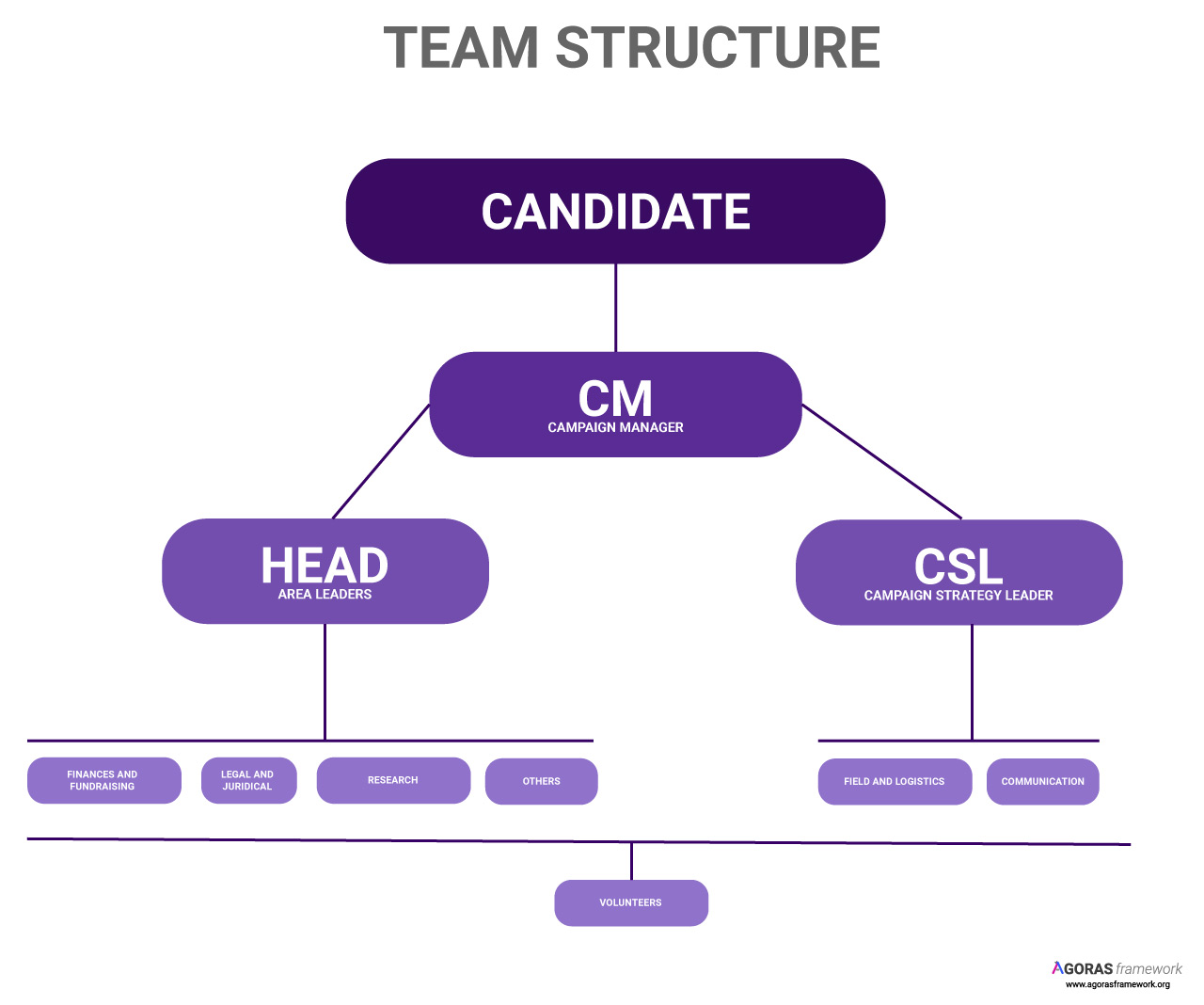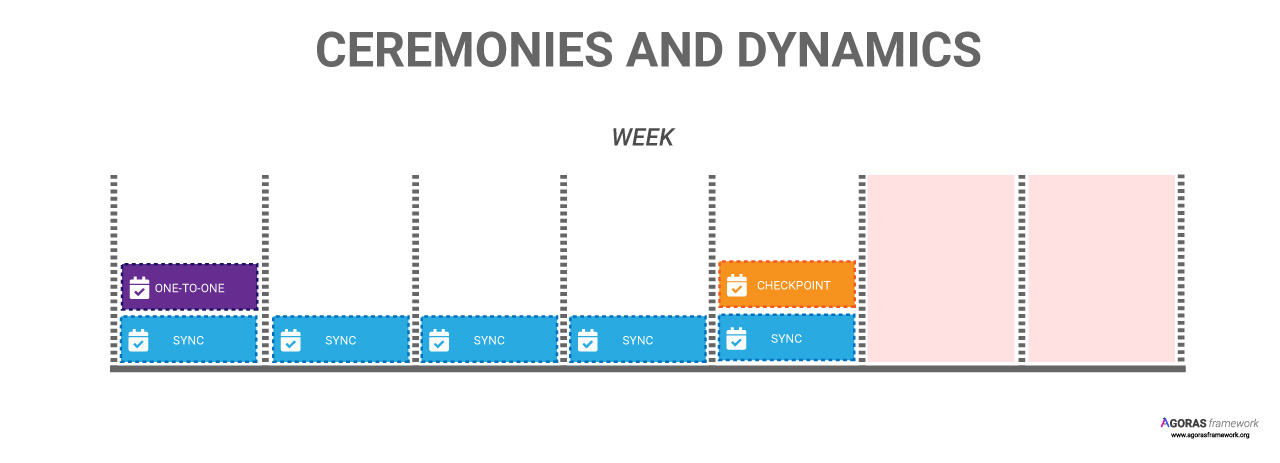Team
OVERVIEW
A campaign with Ágoras is not carried out only on the basis of good candidates, on the contrary, the team is the one who plays the most important role, structuring the entire path that must be traveled during the election, trying to strengthen the candidate for the electorate and thus achieve goals. Therefore, we understand that the construction of the team is made up of the following:
PSC PERFORMANCE
Teamwork is something that can be done in many ways but not all of them can guarantee success. If the members are not actively involved and there is no commitment in the process, it is very likely that the campaign will fail and the candidate will be harmed. The importance of team performance is strongly linked to overall campaign performance.
Following the observations of ¹Mark Jenkins in his book, if a member of the Pit Stop team fails, it can injure the driver and consequently cause the driver to lose the race. That is why the importance of people being together, involved and in harmony is essential for successful performance.
The expression "2 + 2 = 5" is metaphorically considered as the positive effect that a team has when the potential of each one of the members is used. That is why it is important that each individual share the same interest in the campaign and that each of them has something to contribute.
The relevance of the roles and responsibilities of campaign team members is just as important as that of a Pit Stop Crew.
Ágoras reinterprets these observations in a team with a horizontal vision, made up of committed members who are characterized by:
Share a common goal.
Have a holistic view of society and the political world.
Be organized and responsible.
Understand the importance of working together.
Possess skills that contribute to the team.
Identify weaknesses that harm the campaign.
Be forthcoming, with respect but without censorship.
Be able to understand each other's responsibilities.
Be willing to work in an interdisciplinary environment.
Find solutions for conflicts internal and external to the team.
Make decisions based on qualitative and quantitative data.
Take advantage of technological resources and digital tools for communication.
Meet the candidate, share his ideological vision and causes.
Be empathetic with the voter and know how to communicate.
Understand about public needs.
ROLES AND PROFILES
The balance of the team is essential to be able to develop the campaign. For this, it is necessary to know each of the members and understand more about their abilities, behaviors and ideas. The development of insight as a construction tool and the way that individuals relate to each other, contribute to the team's performance increasing effectively and achieving results.
The characteristics of the individuals as a quality factor is not enough if the quantity does not have a direct link. The relationship between the two is not inverse but direct. A group made up of many people, only some of whom fulfill a certain role, turns the team into a sterile and disorganized structure.
The early identification of the profiles of each member allows the strengths and weaknesses of the team to be known and later to be able to organize it in such a way that a balance is maintained that goes beyond a list of tasks to be fulfilled.
By virtue of the aforementioned, we define an organizational structure as follows:
1-CANDIDATE
The candidate is the person running for political office in an election. He is the main protagonist during the electoral campaign.
2-CAMPAIGN DIRECTOR (CM)
The Campaign Director reports directly to the candidate and has the responsibility of building the team together with the candidate.
Identifies the characteristics of individuals, diagnoses skills and defines the roles of each of the team members.
Keeps the team organized and monitors the evolution of the campaign's performance towards voters and the candidate.
Layout the DV Canvas next to the CSL to set initial values.
3-CAMPAIGN STRATEGY LEADER (CSL)
The Campaign Strategy Leader is responsible for managing the timing and planning of the electoral campaign. It works as support for the organization of the campaign together with the CM for communication, field and logistics operations.
It contributes with the validation of planning times, suggestions for decision making and analysis of metrics.
Participate as a conductor of group and individual ceremonies, Road Map and other team dynamics.
4-HEAD
He is a leader responsible for a specific area: Finance and fundraising, legal and juridical, research and others.
5-VOLUNTEERS
They represent the democratic ideal of citizen action. They are people who feel sympathy, either for the candidate or for the party, for which the support is legitimate. Among them it is possible to classify them as Electoral Representatives known as Canvasser, Militants, Pollsters, among others.
The functions and responsibilities of each one is delegated by the CSL or an area Head.
BEHAVIORS
The way a team is built and organized is not simply to follow a list of task instructions, but also to understand the importance of individuals interrelated in a certain way with others. The way each person behaves before the opinion of another and the importance of interpreting communications requires daily monitoring and analysis of how this influences the team's performance.
Classifying behaviors contributes to a better understanding of how team members relate to each other and how to achieve better results when segmented by results, whether positive or negative.
BEHAVIOR CATEGORIES
- SUFFICIENT
It shows tranquility, sympathy and harmony. Try to help others and stay in a neutral environment avoiding conflicts. - FIGHTER
Seek the initiative and kick off. Demonstrates interest in evolving in their roles and responsibilities. Try to know the team's strengths and weaknesses. - LOGICAL
Prioritize the search for information and clarification of doubts. He is analytical and methodical. Analyze steps and procedures. Try to organize the team and avoid disorder. - INDIVIDUALIST
Make own decisions without being subject to rules and procedures in a group environment that requires otherwise. Think and act independently of others creating disorder.
TO-DO
Observe and analyze the behavior of each member.
Categorize the behaviors.
Meet briefly once a week with each team member.
Identify antecedents and consequences of the behavior.
Develop a plan and suggest changes based on successful role models.
Monitor results of evolution and impact on the team through the Average Performance Table.
AVERAGE PERFORMANCE TABLE (APC)
Currently there are various ways to evaluate the performance of team members, so much so that over time new aspects related to people's performance have been added. Through this evaluation, conduct, skills and productivity are objectively and comprehensively measured. In a few words, it serves to understand how the person behaves, does and achieves things within the campaign team.
Following the aforementioned, we designed an Average Performance Table with ten suggested ²Soft Skills:
Quality
Consistency
Communication
Autonomy
Time management
Teamwork
Initiative
Creativity
Honesty
Potential
HOW IT WORKS
The leader rates each soft skill on a scale of 1-10 and the data from this assessment is displayed in columns to later obtain the final average. Each row reflects an identifier and the columns represent separately evaluated soft skills. This performance evaluation is carried out once a week and the customization of soft skills is subject to the leader's discretion.
Rating Scale
1-2: Well below average
3-4: Below Average
5-6: Average
7-8: Above Average
9-10: Well above average
DOWNLOAD AVERAGE PERFORMANCE TABLE MODEL ( APC)
CEREMONIES AND DYNAMICS
> One-to-One
This is a brief meeting carried out by the leader with each of the team members separately. Its purpose is to detect errors that affect their performance as well as the relationship with other members. Suggest possible results and expectations of change.
Participants: Leader or Head + team member.
Frequency: once a week.
Time: 15-30 minutes.
Privacy: Only between the parties involved.
>Sync
This is a brief meeting between the leader and his team members. Its intention is to know among all the opinions and comments on situations, activities, unforeseen events, collaboration between members and the search for results. It does not reflect reports and reports on the status of tasks (PS Log).
Participants: Leader or Head + all team members.
Frequency: Daily.
Time: 30 minutes.
Privacy: Public for the team.
>Checkpoint
This is a meeting between all the members that make up the team including the candidate. Its objective is to review the evolution of the PS Log tasks of each member in a ceremony conducted by the CSL. Monitor performance metrics and make future decisions based on past experience.
Participants: Leader or Head + all team members.
Frequency: Daily.
Time: 30 minutes.
Privacy: Public for the team.
Currently there are different types of teamwork dynamics and include different systematized procedures that adapt to the needs of the campaign, which is why their use is subject to the criteria of each leader.




